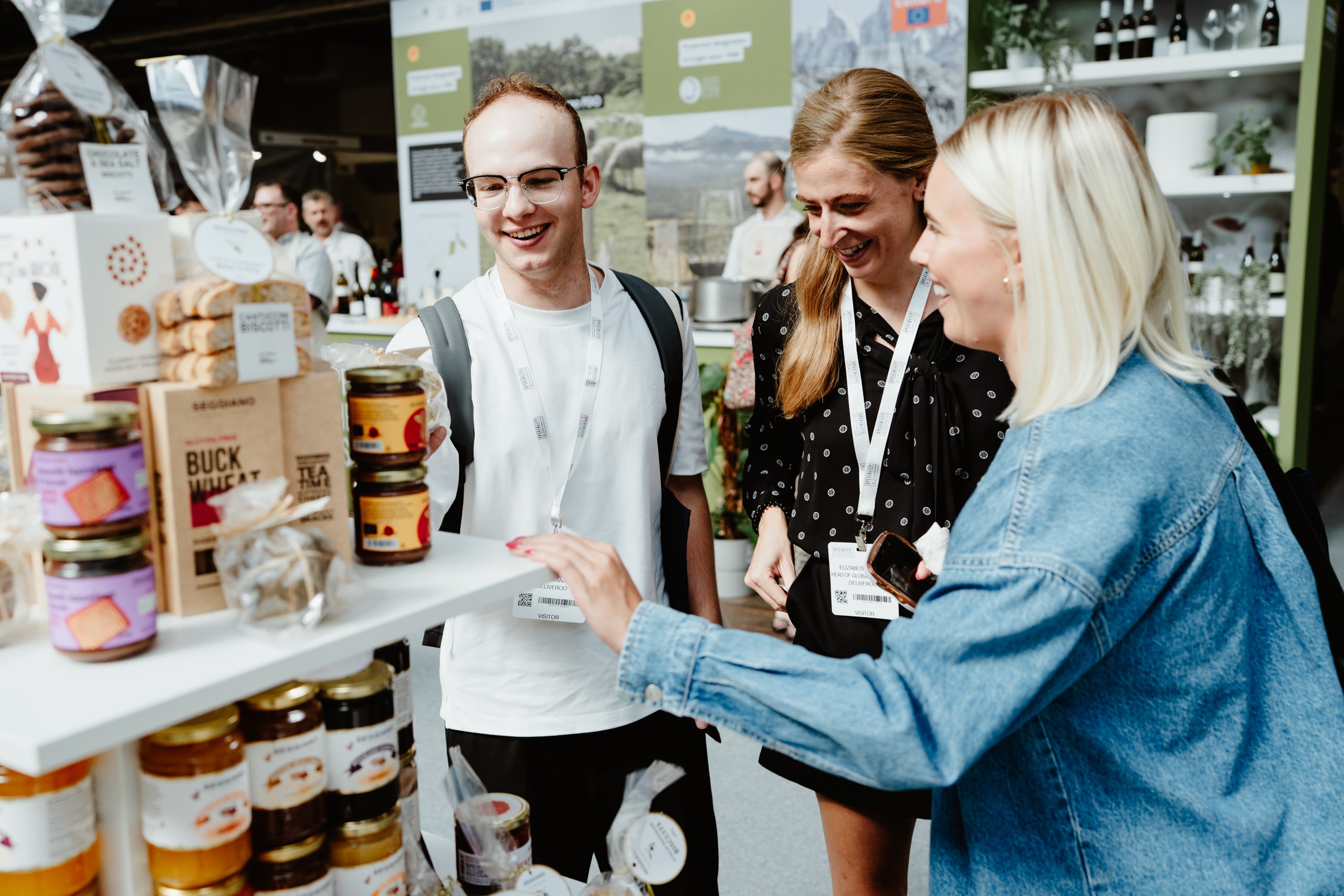At this year’s Speciality and Fine Food Fair held at Olympia, London, UK, producers from Europe, the UK and beyond gathered to showcase the latest innovations in artisanal food and drink.
Sustainability was a key theme at the fair, which featured single-origin chocolate producers, winemakers with refillable bottles, dairy makers that pioneer regenerative agriculture practices, and much more beyond.
From functional olive oil to regen butter, here’s a snippet of the products and people that wowed us with their formats, flavors and brand identities. Stay tuned for more later this week . . .
Pistachio butter, anyone?
With the winter holidays fast approaching, flavored butters are coming in season – and few are as popular in winter as brandy butter.
“We started out with brandy butter and sweet spreads, but as our distribution grew, we started getting requests for savory options too,” told us director Sarah Stokes. The Yorkshire Kitchen was founded by Stokes and her husband Jamie during a parental leave. “I was in marketing, he is a scientist, and we both love butter.”
The Yorshire Kitchen’s sweet butters are packaged in easy to recycle glass jars and comprise flavors such as coffee, salted caramel, whisky, pistachio, and honey & cinnamon. In savory, it offers cajun, black summer truffle, garlic & herb, and peppercorn butter among others.
The company sells D2C and its butters are distributed across UK farm shops and delis.
Golden Hooves’ regenerative dairy
First Milk brand Golden Hooves presented its range of consumer dairy products, including a new range of butter. The company’s BDM Lucy Parr told us the team’s focus has been on increasing brand visibility, bringing in new SKUs and launching the butter in 120 stores.
The brand is also trying to amplify the ‘regenerative ag’ message more to consumers. “We’ve done a lot of good things with that; we’ve been bringing in technology into it so we’ve got QR codes on pack, we’ve been doing surveys and research into how the end consumer perceives regenerative farming. We are continuing to work on our messaging so it lands clearly.”
Mallard Point’s ‘reuse ideology’
England’s Mallard Point claims to be the first drinks producer to use reusable aluminium bottles for both wine and spirits.
Custom–made and reusable down to the swing top closure, the company’s bottles are designed to be sent back to the producer for reuse. Mallard Point’s reuse-refill model incentivizes the consumer to send their empty wine bottle back to the winemaker and receive money off their next purchase (with postage paid and packaging included to make the return process extra smooth), fostering circularity in the supply chain.

The bottle is made of aluminum and there’s a film inside that ensures the wine doesn’t come in contact with the metal, preserving both taste and freshness, we were told at the show.
Mallard Point’s commitment to sustainability spans to its vineyards: the company harvests rainwater which is then used for spraying; has wildflower strips to attract pollinators, and makes its wines entirely from locally–grown grapes. There’s much more beyond: including using spent grapes to feed the Hereford cattle who in turn provide natural fertilizer for the vineyard in a business model that has circularity and sustainability baked in.
Rio Largo’s functional olive oil
South Africa’s Rio Largo showcased a range of award–winning olive oils as well as a new format: refillable decanters (bottom–left on the photo).
While the functional food trend has truly taken off in recent years, Rio Largo’s olive oils – which blend high–quality, locally produced extra virgin olive oil and a range of spices and herbs depending on the bottle – have been around for at least 15 years.
The company’s story begun when co–founder Nick was told by his doctor to incorporate more olive oil in his diet; he then took it upon himself to create unique blends, such as the ginger, Frankincense, pomegranate extract and flaxseed extract one that we tasted at the show. In 2025, he received the SA Olive’s Lifetime Achievement Award for his unique contribution to the South African olive oil industry and innovation.
In the UK, Rio Largo products are imported by Sidwell’s.
Kindred Forest’s rainforest chocolate
Founded by Ben and Katya, who travelled rainforest regions in Latin America and Asia, Kindred Forest’s business model involves partnering with local and Indigenous communities by sharing profits to preserve and regenerate rainforests and support biodiversity in those regions.
The pair had recently visited Colombia and continue on their quest to be ‘cross–pollinators’ of sorts – bringing together stakeholders across the conservation science, food and agriculture space to drive change.
The company’s chocolate and coffee products are single–origin, made with seasonal cacao and coffee beans from different rainforest regions: eg., a dark chocolate bar made from wild–harvested Beniano cacao from the Bolivian Amazon, as seen on the photo above.

